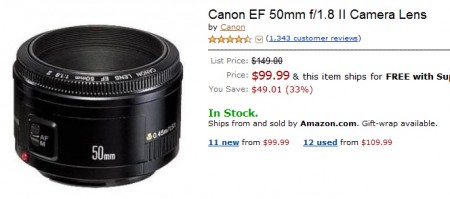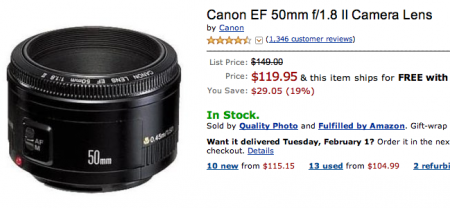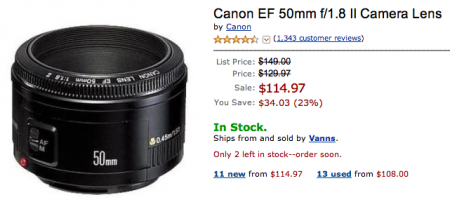The case of the 50mm f/1.8 price shuffle
February 11th, 2011It’s a strange thing to try and wrangle the perfect prize for something you’re after on Amazon.com.
With my new camera, I keep hearing that a prime lens is the way to go. Easy, no fuss, all about framing – stick on a prime lens, forget about zooming, and start taking pictures. For my needs, it’s hard to argue with Canon’s “nifty fifty” 50mm f/1.8 lens, the cheapest lens they offer at about $100.
One hundred dollars is not a big deal. But is $125? Or $119? Depending on what time of day or day of the week you check the nifty fifty’s listing on Amazon, you could pay any one of those prices.

My target price was $99, as seen above. This, combined with a gift card I received over Christmas, would put the 50mm in a very affordable range – especially for a rookie like me.
So I waited. And then…

Not more than a week later, the price jumps 20% to $120.
“Well,” I think to myself. “No sense in buying it for that price, even with my Amazon.com gift card.”
So I check Canon’s own refurbished lens listings to see if I could save any money there. The 50mm is prices very competitely at $80, which – when you combine my Amazon.com gift card and the new, higher price – makes it an appealing option. Sure, the lense is refurbished, but lenses don’t wear out like cameras do.
But by the time you figure in shipping, Canon’s refurbished price isn’t as much of a savings over the Amazon.com price. So I recheck Amazon’s listing.

And what do you know – a $5 drop in price. So within a few days, the price for a Canon 50mm cheap-o lense rises and falls like a bouncy ball: unpredictable, wacky, and hard to catch it at the right time. Some Amazon users have experienced this price switch even after they add something to their cart. Amazon confirms this behavior as standard practice:
Items in your Shopping Cart will always reflect the most recent price displayed on the item’s product detail page. This price may differ from the price shown for the item when you first placed it in your cart. Placing an item in your cart doesn’t reserve the price shown at that time. It is also possible that an item’s price may decrease between the time you place it in your cart and the time you purchase it.
But they offer little in the way of explaining these ghost prices.
Finally, about a week ago, I watched the 50mm price rise and fall for an entire day until it hit $99 again, and then quickly hit the “Add to Cart” button. Might as well catch it while I can, I figured, and not be a slave to market conditions any more.
But what are those marketing conditions? And what logic do they follow?

Complicating things was this “grey market” model of the same lens, on sale for $108. What was this thing doing in the Amazon.com store? What is its function?
The best I can put together, and from my past experiences with buying from Amazon (side note: I always use bloggers’ affiliate link, and I recommend that you do, too, to help out your favorite writers), it has something to do with Amazon.com using different suppliers from around the country. If one supplier runs out of, say, my 50mm lens, Amazon switches gears to another supplier who might charge a higher price.
“Supply and demand, you dummy,” I thought to myself. “This is straight economics.”
Reading Amazon’s own statement on shipping gives some clues:
Retailers like Amazon have the legal right to set their own prices independently, but some manufacturers place restrictions on how those prices may be communicated. Because our price on this item is lower than the manufacturer’s “minimum advertised price,” the manufacturer does not allow us to show you our price until you take further action, such as placing the item in your shopping cart, or in some cases, proceeding to the final checkout stage. The steps required depend on the details of the manufacturer’s minimum advertised price policy. Taking these steps allows Amazon to show you our price consistent with our goal of always offering you the lowest possible prices on the widest selection of products.
Right. So it’s all a shell game of sorts.
For me, it’s standard practice to him and haw over an item for weeks before actually purchasing the thing. Somehow, looking at an item over and over again helps me make consumer decisions. But it’s because of this behavior that I noticed Amazon’s goofy pricing switcheroo.
Knowing this, my neurosis is bound to get worse. If I’m never sure the price I’m paying is the lowest price possible, what sense can be applied to the world around me? It’s frightening in the deepest, most horrifyingly existential way.
Perhaps the point, in the end, is that I got the lens at the lowest price, I was able to take advantage of the my Amazon gift card, and I’ve been very satisfied with the results.
But now there’s an edge to my Amazon shopping that wasn’t there before. Am I getting the best price? Better check later…